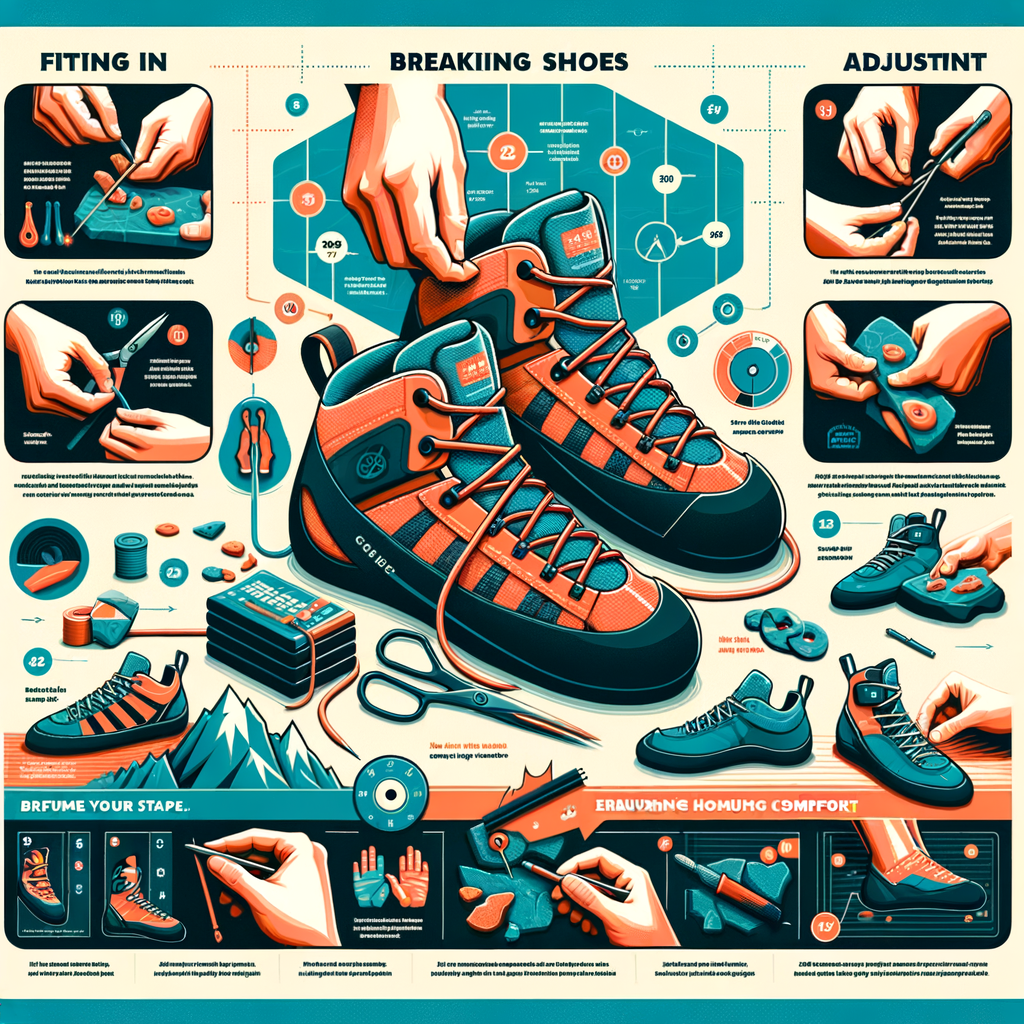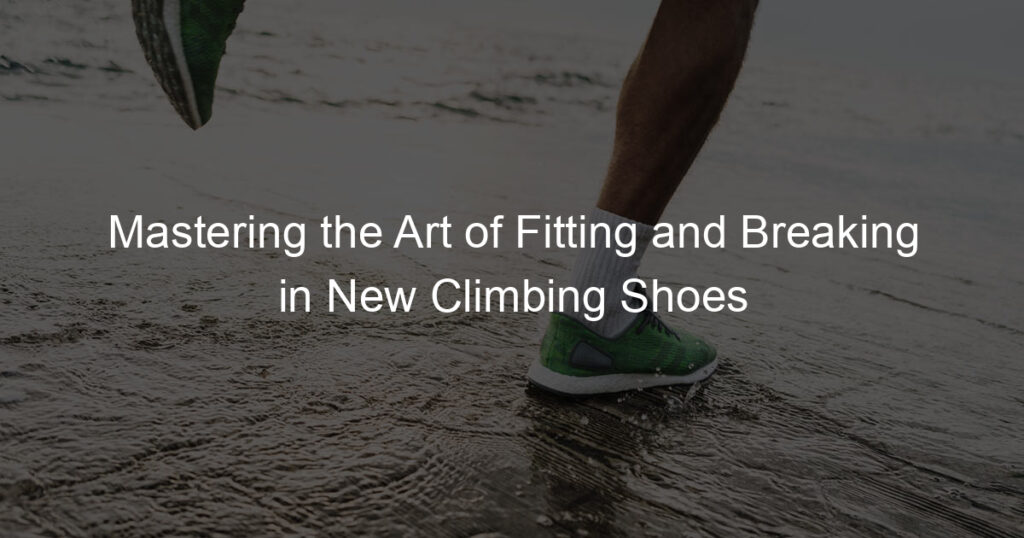
Introduction to Rock Climbing Shoes Fitting Guide
Rock climbing is an exciting and challenging sport that requires not only physical strength but also the right gear. One of the most important pieces of equipment for any climber is their shoes. In this guide, we will discuss the importance of properly fitting rock climbing shoes and provide an overview of some essential footwear tips.
- Importance of Properly Fit Climbing Shoes
- Overview of Rock Climbing Footwear Tips
The fit of your climbing shoes can significantly impact your performance and comfort during climbing. Shoes that are too tight can cause discomfort and even injury, while shoes that are too loose can compromise your grip and stability on the rock. A properly fitted shoe will provide the support and precision needed to tackle challenging routes.
When it comes to choosing and fitting rock climbing shoes, there are several factors to consider. First, remember that climbing shoes should fit snugly, but not painfully. Second, consider the type of climbing you plan to do. Different styles of climbing require different types of shoes. Lastly, remember that your feet can swell during a long day of climbing, so it’s a good idea to try on shoes later in the day when your feet are at their largest.
In the following sections, we will delve deeper into understanding rock climbing shoes sizing, breaking in new climbing shoes, making necessary adjustments, and additional climbing gear tips. By the end of this guide, you will have mastered the art of fitting and breaking in new climbing shoes, enhancing your climbing experience.
Understanding Rock Climbing Shoes Sizing
When it comes to rock climbing, the right shoe size can make a significant difference in your performance and comfort. Understanding how climbing shoe sizes compare to regular shoe sizes is crucial. Let’s delve into this topic.
Size Comparison: Regular Shoes vs Climbing Shoes
It’s essential to note that climbing shoes and regular shoes are not sized the same way. Here’s why:
- How climbing shoe sizes differ from regular shoe sizes
- Key considerations when choosing climbing shoe size
Climbing shoes are designed to fit more snugly than regular shoes. They are meant to provide a tight grip on your feet, allowing you to maintain better control when climbing. As a result, climbing shoe sizes are usually smaller than regular shoe sizes. For instance, if you wear a size 9 in regular shoes, you might need a size 8 or 8.5 in climbing shoes.
When choosing a climbing shoe size, consider the type of climbing you’ll be doing. For bouldering and sport climbing, a tighter fit might be beneficial. However, for traditional climbing or long multi-pitch routes, a slightly looser fit might be more comfortable. Always remember, comfort should be your priority.
Understanding the difference in sizing between regular shoes and climbing shoes can help you make an informed decision when purchasing your next pair of climbing shoes. Remember, the right fit can significantly enhance your climbing experience.
Sizing for Comfortable Climbing Shoes
When it comes to rock climbing, comfort is key. The right shoe size can make all the difference in your climbing experience. Let’s delve into the factors that influence comfort in climbing shoes and how to ensure a comfortable fit.
- Factors Influencing Comfort in Climbing Shoes
- Size: A shoe that is too tight or too loose can cause discomfort and affect your climbing performance.
- Material: The material of the shoe can also impact comfort. Synthetic materials tend to be more comfortable but less durable, while leather shoes are more durable but may require a break-in period.
- Shape: The shape of the shoe can also affect comfort. Some climbers prefer a more aggressive, downturned shape, while others prefer a flatter, more neutral shape.
- How to Ensure a Comfortable Fit
- Measure Your Foot: Start by measuring your foot length, width, and arch height. This will help you find a shoe that fits your unique foot shape.
- Try on Multiple Sizes: Don’t be afraid to try on multiple sizes to find the perfect fit. Remember, climbing shoe sizes can differ from regular shoe sizes.
- Break in Your Shoes: New climbing shoes may feel tight at first. Give them some time to break in and mold to your foot shape.
Several factors can influence the comfort of your climbing shoes. These include:
Ensuring a comfortable fit in your climbing shoes involves a few key steps:
In conclusion, finding the right size for your climbing shoes is crucial for comfort and performance. By considering factors such as size, material, and shape, and taking the time to ensure a proper fit, you can enhance your climbing experience and reach new heights.
Breaking in New Climbing Shoes
When you first purchase a pair of new climbing shoes, they may feel a bit uncomfortable. This is normal. The shoes need to be broken in. This process involves wearing the shoes regularly until they mold to the shape of your feet. Let’s explore the break-in process and how to avoid common mistakes.
New Climbing Shoes Break-in Process
- Step-by-step guide to breaking in new climbing shoes
- Start by wearing your new shoes at home for short periods. This will help your feet get used to the new fit.
- Gradually increase the amount of time you wear the shoes. You can start by wearing them for 15 minutes at a time, then gradually increase this to 30 minutes, then an hour, and so on.
- Use your shoes for light climbing sessions. This will help the shoes mold to the shape of your feet.
- Remember to take breaks. If your feet start to hurt, take the shoes off and give your feet a rest.
- Common mistakes to avoid
- Don’t rush the process. Trying to break in your shoes too quickly can cause discomfort and potential injury.
- Avoid wearing your new shoes for long climbing sessions right away. This can cause blisters and other foot problems.
- Don’t ignore pain. If your shoes are causing you pain, it’s a sign that they may not be the right fit.
Here is a simple guide to help you break in your new climbing shoes effectively:
When breaking in new climbing shoes, there are a few common mistakes that you should avoid:
Remember, breaking in new climbing shoes takes time and patience. By following these steps and avoiding common mistakes, you can ensure that your new shoes will provide the comfort and support you need for successful climbing.
Preparing New Rock Climbing Shoes
When you get a new pair of rock climbing shoes, it’s important to prepare them properly before you start using them. This will help ensure they last longer and perform better. Here are some tips to help you prepare your new rock climbing shoes:
- Pre-wear preparation tips
- How to speed up the break-in process
Before you wear your new rock climbing shoes for the first time, there are a few things you should do. First, inspect the shoes for any defects or damage. This includes checking the rubber soles for any peeling or cracks, and making sure the laces or Velcro straps are secure and not frayed. You should also try on the shoes to make sure they fit properly. They should be snug but not too tight, and your toes should touch the end of the shoe without being cramped.
Breaking in new rock climbing shoes can sometimes take a while, but there are ways to speed up the process. One method is to wear your shoes around the house for short periods of time. This can help the shoes mold to your feet without the added pressure of climbing. Another method is to soak your shoes in warm water for about 20 minutes, then wear them until they dry. This can help the shoes stretch and conform to your feet more quickly. However, be sure to check the manufacturer’s instructions before trying this method, as it may not be suitable for all types of shoes.
Remember, the key to a successful climb is not just having the right gear, but also knowing how to use and take care of it properly. By taking the time to prepare your new rock climbing shoes, you can ensure they provide the best performance and longevity.
Climbing Shoes Adjustment
Adjusting your climbing shoes is a crucial step in ensuring comfort and safety while rock climbing. Let’s explore how to adjust your shoes for an optimal fit and when it might be necessary to consider professional adjustment.
Adjusting for Optimal Fit
Getting the perfect fit for your climbing shoes can significantly enhance your climbing experience. Here are some steps to help you adjust your shoes for a better fit:
- How to adjust climbing shoes for a better fit
- When to consider professional adjustment
Start by wearing your climbing shoes and standing up. Your toes should lightly touch the front of the shoe without causing discomfort. If your shoes are too tight, try loosening the laces or straps. If they’re too loose, consider adding an insole or wearing thicker socks. Remember, the goal is to find a balance between comfort and performance.
Despite your best efforts, you might still struggle to find the perfect fit. In such cases, it’s advisable to consider professional adjustment. If your shoes are causing pain, leaving blisters, or if your feet are slipping inside the shoes, these are signs that you need professional help. A professional can adjust the size, width, and shape of your climbing shoes to better suit your feet.
Remember, the key to a successful climbing experience is comfort and safety. So, don’t hesitate to seek professional help if you’re having trouble adjusting your climbing shoes.
Maintaining Your Climbing Shoes
Just like any other piece of equipment, climbing shoes need regular maintenance to ensure they last longer and perform at their best. Here are some tips and guidelines to help you keep your climbing shoes in top shape.
- Regular maintenance tips for longer-lasting shoes
- When to consider replacing your climbing shoes
Firstly, always clean your shoes after each climbing session. Dust, dirt, and sweat can degrade the rubber soles of your shoes, reducing their grip. Use a soft brush and a mild detergent to gently clean your shoes, then let them air dry. Avoid leaving them in direct sunlight or near a heat source, as this can cause the rubber to crack.
Secondly, avoid wearing your climbing shoes when you’re not climbing. Walking around in your climbing shoes can wear down the soles and reduce their effectiveness when you’re on the rock face.
Lastly, store your shoes properly when they’re not in use. Keep them in a cool, dry place and avoid squashing them under heavy objects. This can help to maintain their shape and prolong their lifespan.
Even with the best care, climbing shoes will eventually wear out and need to be replaced. Here are some signs that it might be time for a new pair:
If the soles of your shoes are worn thin or have holes in them, it’s time for a replacement. Worn soles can reduce your grip and make climbing more dangerous.
Another sign is if the shoes have lost their shape or are no longer comfortable. Climbing shoes should fit snugly but not painfully. If your shoes are causing discomfort or blisters, it might be time for a new pair.
Finally, if you’re finding that your shoes are no longer providing the level of performance you need, it might be time for an upgrade. Newer models of climbing shoes often offer improved design and technology that can enhance your climbing experience.
Additional Climbing Gear Tips
Aside from your climbing shoes, there are other pieces of equipment that are essential for a safe and successful climbing experience. Let’s delve into some tips on choosing the right climbing gear.
Choosing the Right Climbing Gear
Choosing the right climbing gear is crucial for your safety and performance. Here are some key points to consider:
- Essential climbing gear for beginners
- Climbing Helmet: A helmet is a must-have for safety. It protects your head from falling debris and in case of falls.
- Climbing Harness: This is what connects you to the climbing rope. It should be comfortable and fit well.
- Climbing Rope: The rope is your lifeline. Ensure it’s specifically designed for climbing and is of the right length for your climb.
- Belay Device: This device controls a rope during belaying. It’s used to create friction to slow down or stop the rope.
- How to choose quality climbing gear
- Brand Reputation: Opt for brands known for their quality and durability. Research and read reviews before making a purchase.
- Safety Standards: Ensure the gear meets the necessary safety standards. Look for certifications from recognized bodies like the UIAA or CE.
- Comfort and Fit: Your gear should be comfortable and fit well. Ill-fitting gear can hinder your performance and even pose safety risks.
- Material: The material of the gear matters. For instance, ropes should be dynamic and helmets should be lightweight yet sturdy.
As a beginner, you might feel overwhelmed by the wide array of climbing gear available. However, there are a few essentials that you should prioritize:
Quality is paramount when it comes to climbing gear. Here are some tips to help you make the right choice:
Maintaining Your Climbing Gear
Just like any other sport, rock climbing requires the right gear. But, it’s not enough to just have the right equipment. You also need to know how to maintain it. Here are some tips on how to clean, store, and know when to replace your climbing gear.
- Tips for cleaning and storing your climbing gear
- Cleaning: After each use, wipe down your gear with a damp cloth to remove dirt and sweat. For a deeper clean, use a mild soap and water solution. Rinse thoroughly and let it air dry.
- Storing: Store your gear in a cool, dry place away from direct sunlight. Avoid places with high humidity as it can cause the gear to rust. Keep your gear organized and easy to find for your next climbing adventure.
- When to replace your climbing gear
- Wear and Tear: If your gear shows signs of significant wear and tear, such as fraying ropes or worn-out soles on climbing shoes, it’s time to replace them.
- Age: Even if your gear looks fine, it’s recommended to replace it every few years. Over time, materials can degrade, reducing their effectiveness.
- After a Fall: If you’ve had a major fall, it’s a good idea to replace your gear. Even if it looks okay, the impact could have caused unseen damage.
Keeping your climbing gear clean and properly stored can extend its lifespan and ensure it performs well. Here are some simple steps to follow:
Knowing when to replace your climbing gear is crucial for your safety. Here are some signs that it’s time for a replacement:
Remember, maintaining your climbing gear is not just about saving money. It’s about ensuring your safety while enjoying the sport you love. So, take the time to clean, store, and replace your gear as needed.
Conclusion: Mastering the Art of Fitting and Breaking in New Climbing Shoes
As we reach the end of our journey, it’s time to look back and reflect on the key points we’ve covered. The art of fitting and breaking in new climbing shoes is a crucial part of your rock climbing experience. Let’s summarize our key takeaways and discuss the importance of properly fit and broken-in climbing shoes.
- Recap of key takeaways:
- Final thoughts on the importance of properly fit and broken-in climbing shoes:
Understanding the correct size of your rock climbing shoes is the first step towards a successful climb. Remember, the perfect fit is snug but not painfully tight. Breaking in your new shoes gradually will help them mold to your feet, enhancing your grip and comfort. Adjusting your shoes for different climbing scenarios can also improve your performance. Finally, while shoes are important, don’t forget about other climbing gear that can contribute to your safety and success.
Properly fit and broken-in climbing shoes are not just about comfort. They are a key element in your climbing performance and safety. A well-fitted shoe provides the grip you need to navigate challenging terrains, while a broken-in shoe molds to your unique foot shape, providing stability and reducing the risk of injuries. As the famous climber, Lynn Hill once said, “In climbing, your feet are your foundation. Treat them well.”
Mastering the art of fitting and breaking in new climbing shoes is a journey, not a destination. It requires patience, practice, and a willingness to learn. But with the right knowledge and approach, you can turn this journey into a rewarding part of your climbing adventure.









